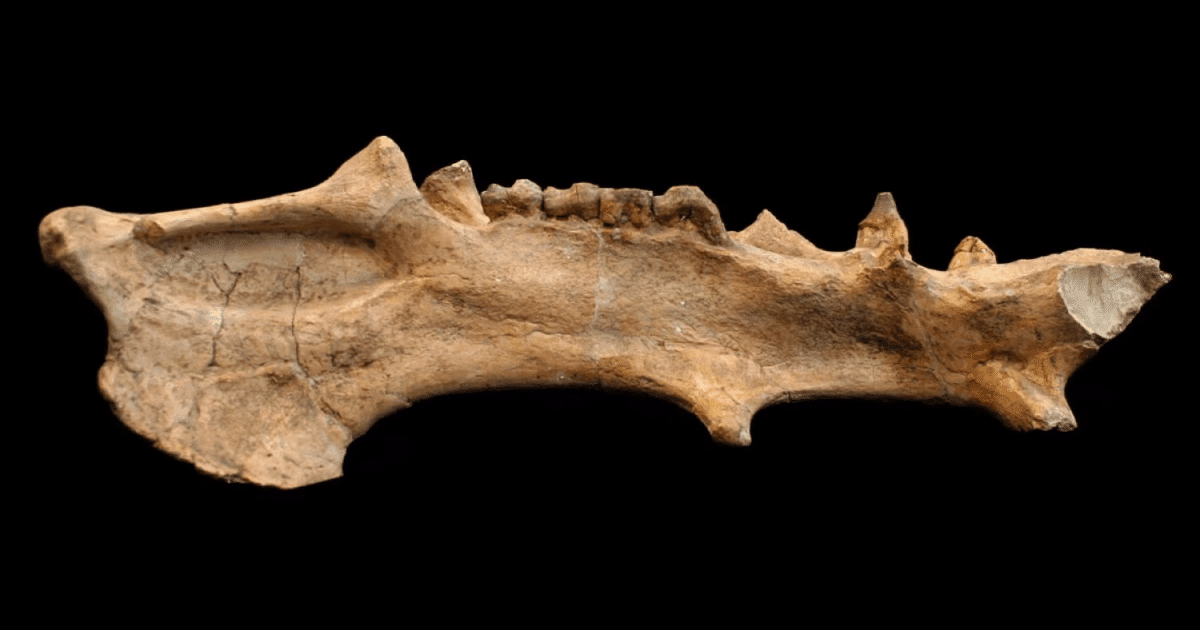North America’s prehistoric landscape was once home to a unique creature known as Archaeotherium, often referred to as “hell pigs.” These pig-like animals, which lived around 30 million years ago, have long intrigued paleontologists with their mysterious habits and massive size. Recent research has uncovered new insights into their feeding behavior, revealing some fascinating differences between the smaller and larger species.
The Mysterious Archaeotherium: More Than Just “Hell Pigs”
The Archaeotherium, a creature that roamed North America during the late Eocene to Miocene epochs, was not your average pig. Despite their name, “hell pigs,” they were more closely related to hippos and whales than the pigs we know today. These creatures grew to immense sizes, with some species weighing over 2,000 pounds and towering as tall as humans when standing on all fours. Their appearance, with a head that accounted for about 30% of their total body length, made them stand out in the ancient ecosystem. However, their massive size didn’t translate to superior intelligence. LiveScience reports that their brain-to-body mass ratio was similar to that of reptiles, making them relatively unintelligent for their size. “Their heads were massive, but they had little tiny brain cases,” said Brynn Wooten, a doctoral candidate at Vanderbilt University, in a recent interview.
Despite their low cognitive abilities, Archaeotherium’s anatomy and size suggest they were formidable creatures in their time. The key to understanding their lifestyle and behavior lies in the structure of their teeth and the wear patterns found on them. These patterns reveal much about their feeding habits and, more intriguingly, their roles within the ecosystem.
Teeth Tell a Tale: The Bone-Crunching Abilities of Larger Archaeotherium
One of the most striking revelations from recent research is the discovery that larger Archaeotherium species could crush bones. This was a characteristic previously associated with much more specialized carnivores like lions and hyenas. By examining the teeth of these ancient creatures, researchers found that the larger specimens exhibited a wear pattern similar to that of modern-day bone-crunching predators.
“It’s really interesting that the large ones are capable of crunching bones,” said Larisa DeSantis, an associate professor of biological sciences at Vanderbilt University. “The small ones are not.”
This bone-crushing ability suggests that the larger Archaeotherium may have had a different diet and feeding strategy compared to their smaller relatives. While the smaller hell pigs likely stuck to softer food sources, such as vegetation or smaller prey, the larger species may have scavenged from the kills of other predators, using their size to intimidate competitors and access carcasses that others couldn’t reach. Alternatively, they may have consumed harder, more fibrous plant material, such as tubers or woody vegetation, in addition to scavenging bone.
The idea of these massive creatures potentially scavenging like modern-day hyenas adds an interesting layer to our understanding of prehistoric ecosystems. Large Archaeotherium species might have used their size as an advantage in dominating smaller carnivores or competing for food, much like modern apex predators do today. The comparison to lions and hyenas emphasizes their role in the food chain, suggesting they were opportunistic feeders that thrived by exploiting a variety of resources.

Smaller Species: Specialized for Softer Fare
Not all Archaeotherium were capable of such aggressive feeding strategies. The smaller species, which were likely much less imposing, had teeth that were better suited for softer, plant-based foods or smaller prey. These creatures did not exhibit the same bone-crushing wear patterns as their larger counterparts. Instead, their teeth showed evidence of shearing, indicating a diet of vegetation or softer animal matter.
This difference in tooth wear supports the idea that size played a crucial role in the dietary habits of these creatures. As Brynn Wooten explains, “We can’t assume that they were doing the same thing,” referring to the dietary differences between the smaller and larger species of Archaeotherium. The disparity between these two groups suggests that different feeding strategies were in place depending on the size of the creature, which in turn could have influenced their social behavior and their place in the ancient ecosystem.
The fact that size could determine whether an Archaeotherium focused on scavenging or consuming softer foods adds another layer of complexity to the behavior of these animals. The smaller species may have been more specialized, targeting specific plant life or less dangerous prey. In contrast, the larger species had a broader range of feeding options, including the potential to consume tougher foods or compete for larger, more challenging meals.
Unveiling Ancient Feeding Strategies
What does this research mean for our understanding of prehistoric feeding behaviors? The new findings suggest that feeding strategies were not only dictated by size but also by the ecological role these animals played. The large Archaeotherium might have been more opportunistic, taking advantage of carcasses or difficult-to-access plant matter, while the smaller ones focused on different food sources entirely. This discovery could help paleontologists piece together a clearer picture of the ancient food web and how these creatures interacted with their environment.
The ongoing research by Brynn Wooten and her colleagues at Vanderbilt University is still in its early stages, but it has already begun to shed light on the complex feeding behaviors of these prehistoric creatures. The next steps in their work include using advanced techniques, such as calcium isotope analysis, to further explore the possibility that these creatures consumed bone as part of their diet.
These findings challenge the simplistic view that ancient animals like Archaeotherium were merely scavengers or vegetation eaters. Instead, they offer evidence of a diverse range of behaviors that reflect a complex and dynamic ecosystem. The variety in feeding strategies highlights the adaptability of these creatures and their ability to thrive in a competitive, ever-changing environment.

